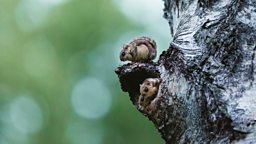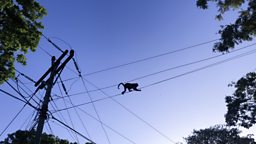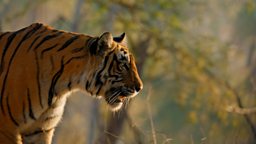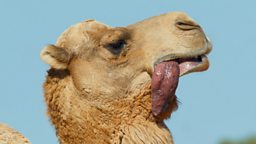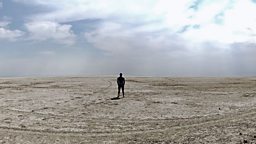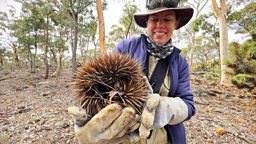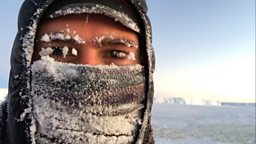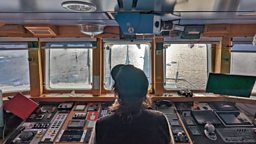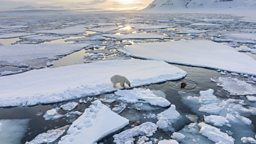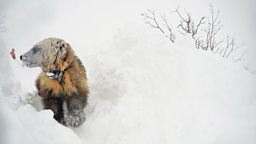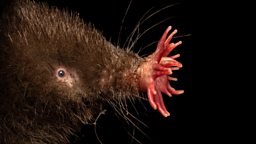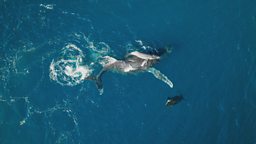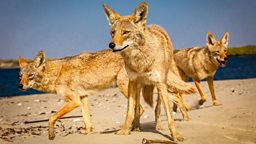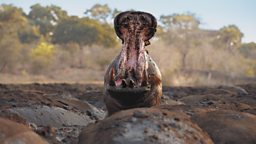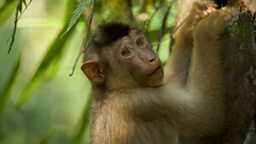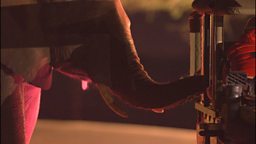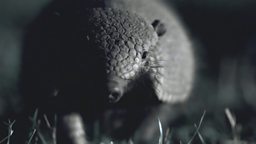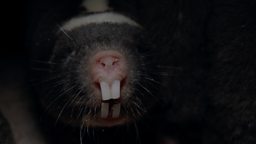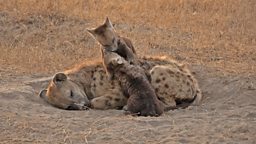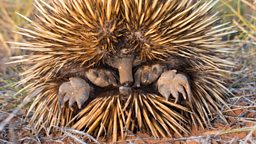Filming pika: Making hay while the sun shines
By Mammals Researcher, Tom Parry
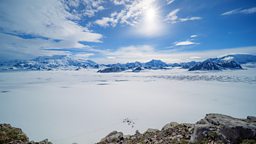
The size of guinea pig, the shape of a tennis ball, and with a squeak like a dog’s chew toy .. one unlikely star of the Mammals Cold episode is a real-life Pokémon, the pika. There are around 30 species of pika across the globe and, like their close relatives rabbits and hares, none of them hibernate. Instead, they see out the harsh winter months by feeding on a cache of hay they stocked the previous summer. Our mission was to film one particularly special species of pika gathering together their precious larders of twigs, grasses and flowers in the most unlikely of places.
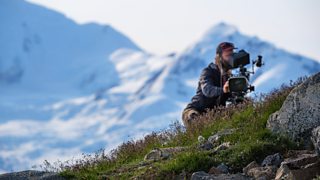
We gathered at a tiny airfield on the outskirts of the mighty Kluane National Park. In the heart of Yukon’s imposing St. Elias mountains, Kluane contains Canada’s tallest peaks and the world's largest non-polar icefields. It offers a snapshot into life during the Ice Age and is home to a tiny relic of those times – the collared pika.
This species is hardier than its more common cousin the American pika and restricted to the remotest regions of North America. Our filming site was a gigantic, rocky outcrop known as a ‘nunatak’. Nunataks are mountain summits that protrude from underneath an ice sheet. Essentially the tip of an iceberg in reverse, they are the peaks of vast mountains buried under millions of tonnes of ice. We knew of one that was home to a small population of pika, discovered by camera operator and pika-expert Kieran O’Donovan - but reaching it meant travelling 50km across, and 3km up, into the enormous mountain range. In the very heart of the ice fields, we would set up a camp and live on a glacier in complete isolation for nearly a month.
With all our supplies laid out on the runway, cramming it all in to just three helicopter journeys seemed an impossible feat. Tents, stoves, fuel, generators, camping supplies, food – and that’s before you get to the filming equipment! It was a game of Tetris getting everything in, but we managed it. Mountain Guide James Minifie joined Kieran on the first flight, and the rest of the crew followed second.
The journey into the icefields was simply spectacular. The further in we flew the more I lost any sense of scale - as vast glaciers snaked their way up valleys kilometres wide, sprinkled with spiralling crevasses and deep turquoise pools, eventually spreading into an ocean of pristine, white snow and ice, through which jagged shards of rock rose into the sky – in was just unbelievable. Despite snapping away madly throughout I never managed to capture any photos that did it justice.

After what felt like hours, we flew over one ridge and the pilot said “oh, looks like they’ve already made a start on camp”. I squinted to see what he was pointing at – surely those tiny spots weren’t our tents?! I was speechless, that was the first time I truly appreciated the immensity of this landscape.
We couldn’t wait to get up there and find the little fluffballs.
As we landed and unloaded our kit, we immediately realised how harsh this environment was going to be. At 3000m, the sun was vicious. As I slapped on gallons of sunblock and pulled on my snowshoes I could feel the altitude immediately – it was like being drunk, only not so pleasant! It took all my concentration to put my tent up.
I then realised that we were building our camp to a soundtrack of pika squeaks – our position on the glacier was 300m below the nunatak’s filming site, but their calls carried through the valley and it was clear they were already hard at work making their preparations for winter. We couldn’t wait to get up there and find the little fluffballs.
Being so far north at the height of summer, it never got dark. Around 1am the sun dipped below the horizon for a few hours, casting the landscape into a beautiful blue hue, and at ‘night’ the temperature would plummet to well below zero. As I climbed into my sleeping bag I could feel the sweat I’d worked up in the day freezing on my face.
We made our first excursion up the nunatak the next morning. To reach its base we had to cross 500m of the glacier. Traversing a ‘wet’ glacier (covered in a blanket of snow) such as this is extremely dangerous because the crevasses are completely obscured. We travelled slowly, roped together in a line, maintaining a strict distance from each other. Our incredibly experienced mountain guide James led the way, probing the snow in front of him for crevasses and cautiously calving out a safe route that would become our daily commute.
At the base of the nunatak we detached ourselves and began the long scramble up the rockface. As I climbed it dawned on me that I’d been living my life on National Trust-maintained paths.. this was a different kettle of fish! The climb took about 2hrs, but once we were up we were rewarded with a spectacular view of the valley – and of course, some squeaky, little pikas.
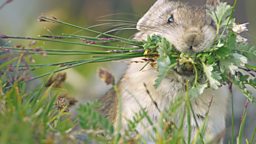
It’s truly extraordinary that pikas can survive in these icefields. So little is known about the tiny, isolated populations here – perhaps the biggest mystery is how they manage to maintain genetic diversity given the clear barriers between the nunatak habitats. They are known to disperse directly over the glaciers that bridge their populations, but as these can be tens of kilometres wide, it’s astonishing that such a tiny creature can pull off such a journey.
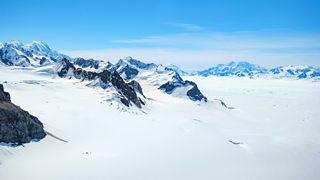
Doing this mind-blowing location justice felt a challenge. But even more daunting was realising what tricky customers these pika would be to film. They were tiny - and very fast! The scree that formed their habitat was a complete maze, they would pop up all the over the place like some kind of crazy game of whack-a-mole. We spent several hours just watching them, learning their routes and planning our strategy.
The pika were obviously creatures of habit, each taking specific routes between the patches of wildflower meadow and their hay pile homes. The different pika also seemed to have wildly varied personalities. Some were very bold and would happily approach us, others were so shy we would get only fleeting glances, while some would puff up their chests and peep threateningly at us.
But one pika jumped out straight away. Many pika species are known to steal from each other, a behaviour known as ‘kleptoparastism’. And it’s been demonstrated that this trait varies throughout a population, with specific individuals recurring offenders. This male was clearly exactly that – his hay pile was in a prime position and was one of the grandest, yet he didn’t seem to be doing much work! Sure enough, the more time we spent with him the more we realised he was living a life of crime.
We took a two-pronged approach. Camera operators Kieran O’Donovan and Max Smith set up in tactical spots with the best views of the haying routes. Meanwhile, Assistant Producer Sarah-Jane Walsh and myself carefully placed tiny remote cameras in the hay piles to capture footage inside without disturbing the residents.
The weather was so variable. On clear days the sun was brutal, but then without warning storm-clouds would roll through the valley and limit our visibility to barely a metre. When hit by snow-storms, we would frantically wrap ourselves up and try to keep the cameras dry - but the resilient little pika would continue to hop about gathering their flowers, totally unbothered! They knew their summer was short and they had to make the most of every second.
I often think of those little pikas. We spent just a few weeks with them during their brief summer, and that was a gruelling, tough expedition (if an incredible one) for us. But the vast majority of their year is spent in a different, utterly unforgiving world. All those long winter months enduring brutal temperatures, with barely any daylight, while fierce storms batter the rocky outcrop they have made their home against the odds. It’s absolutely remarkable that such a tiny creature is able to survive up there – and even more amazing that the secret to their success is simply a knack for gardening.
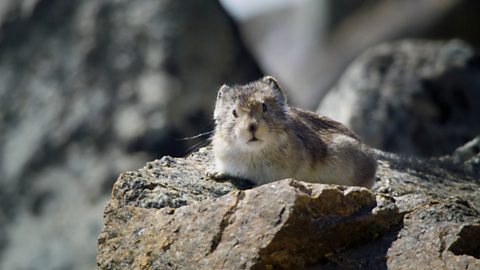
Naughty neighbours!
Pikas rush to collect and store food, but they must remain vigilant - thieves are about!

